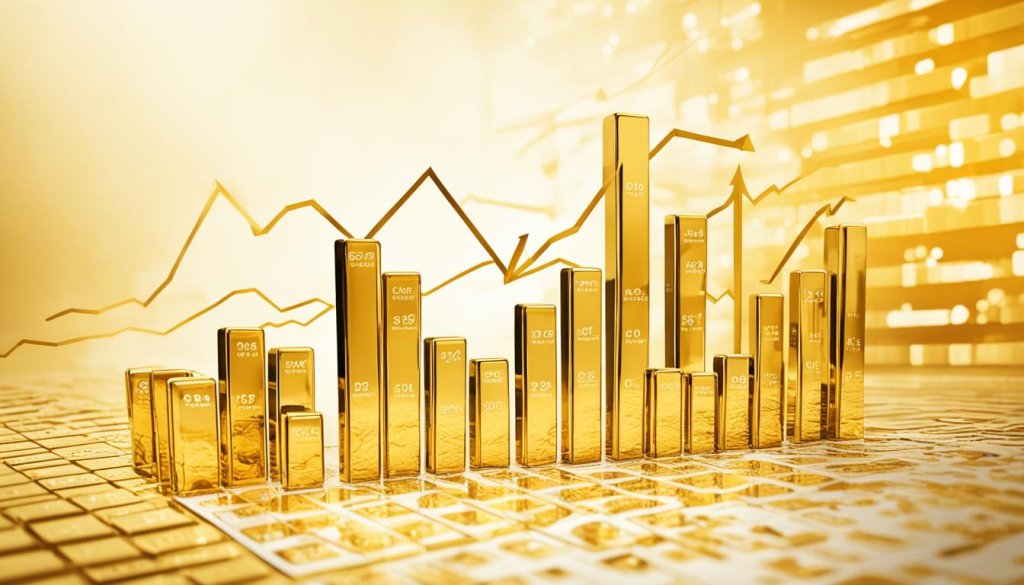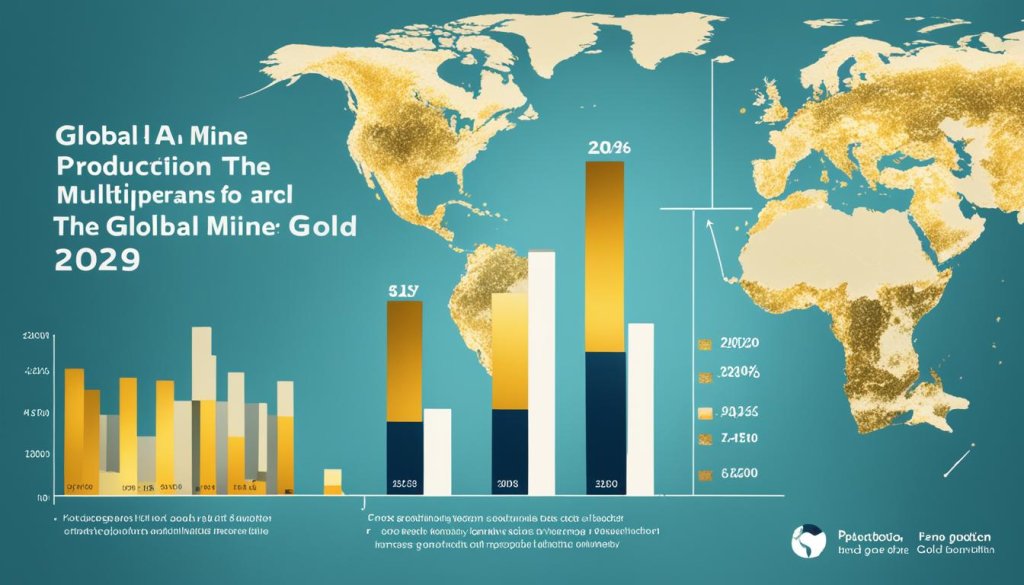Gold Price Trends And Market Analysis 2023

Analyzing the precious metals market trends throughout 2023 unveils a series of intriguing changes, with the gold market asserting its resilience and strength. A detailed gold price analysis reveals a historical year-end London Bullion Market Association (LBMA) gold price of US$2,078.4/oz, culminating in an impressive 15% annual return above the average gold price. Not just a fleeting moment of success, this represents an 8% increment from 2022, a figure reflective of the gold price performance 2023 has sustained despite global economic headwinds.
The market’s robust performance has been bolstered by multiple factors, including central bank purchases nearing a significant 1,037 tonnes (t), substantial over-the-counter (OTC) investments, and steady demand for jewelry, predominantly from China’s enduring market. This has unfolded even as the gold market trends were impacted by contractions in sectors such as technology and shifting Exchange Traded Fund (ETF) landscapes.
Introduction To The Gold Price Performance Of 2023
The landscape of the gold market in 2023 was as dynamic as ever, with gold price trends painting a complex picture of both challenges and triumphs. An in-depth gold market review reveals that despite the headwinds faced by various investment sectors, the demand for this precious metal reached unprecedented heights, reshaping traditional investment approaches. Analyses also reflect a nuanced view of consumer and central bank behavior that played a significant role in these trends.
Key elements contributing to the noteworthy gold demand performance include:
- Soaring overall demand including Over-The-Counter (OTC) trades and stock flows, which tallied up to 4,899 tonnes (t).
- Resilient jewelry market demand that remained steadfast even as the gold prices climbed.
- Central bank purchases that continued to bolster the gold market fundamentals.
- Reduced investments in Exchange-Traded Funds (ETFs) which contrasted with the larger positive outlook.
To encapsulate the year’s activity, a nuanced gold investment analysis is imperative. Despite the dip in technology sector demand for gold, the market remained robust, buoyed by strategic central bank operations and a consistently strong appetite for gold amongst consumers. The interplay of these factors ensured that gold held its allure as both a safe haven and a key asset in a diversified investment portfolio.
Record-Breaking Central Bank Purchases And Their Impact
The landscape of the gold market experienced a significant shift in 2023 when central banks around the globe increased their gold reserves at a record-breaking rate, solidifying the role of central bank gold purchases as one of the foremost gold demand drivers. Emerging market central banks, in particular, exhibited an intensified appetite for gold, asserting a considerable central bank influence on gold prices and pointing to a more systemic reliance on the precious metal.
Dynamics Of Central Bank Gold Demand
In 2023, the aggressive acquisition of gold by central banks culminated in an astounding 1,037 tonnes in net purchases. This flurry of activity not only underscores the confidence in gold’s enduring value but also illustrates the strategic shift towards strengthening monetary stability. The sheer volume of these acquisitions highlights their influence as a gold market valuation factor, with emerging markets playing a pivotal role in bolstering the global demand for gold.
Contribution To Gold’s Valuation
Despite other economic headwinds, such as increases in bond yields and geopolitical tensions, the singular dedication of central banks to fortify their gold reserves proved to be a dominant factor in the gold price valuation in 2023. This unrelenting demand from central banks has served as both a shield and propellant for the valuation of gold, asserting central bank gold influence as an engine of market stabilization and an arbiter of gold’s market trajectory.
Gold ETFs And Their Influence On Market Dynamics
The gold ETFs market impact is a multifaceted aspect of the precious metals trade. Despite experiencing ETF outflows for the third year in a row, the resilience of the gold market was undeniable, with gold prices not only withstanding this sell-off but actually experiencing elevations. This dynamic illustrates the nuanced role that ETF dynamics in gold pricing play. While ETFs are influential market players, their impact on the gold price is not always directly correlated with inflows and outflows.
In 2023, the phenomenon of ETF outflows and gold price dynamics was particularly evident. A significant 244 tons were pulled from gold ETFs, with most activity occurring in October. However, these outflows were met with a notable deceleration as the year drew to a close. In the context of these outflows, a persistent ascent in the price of gold communicated robust market confidence—a key indicator that factors beyond ETF movements were bullish for gold pricing.
- Reduced outflow rates towards the end of 2023
- Rising gold prices despite ETF withdrawals
- Strengthening underlying market confidence
Such a scenario foregrounds the complexity behind ETF dynamics in gold pricing and how multiple vectors, other than ETF movements, such as central bank acquisitions and jewelry demands, collectively frame the gold market landscape.

Understanding The Dip In Gold-Use In Technology
Despite gold’s timeless allure and enduring value, 2023 saw an unexpected decline in its utilization within the technology sector. Traditionally a pillar in electronic manufacturing, the dip in gold consumption technology has rippled across the gold market supply demand conversation. Yet, the final quarter offers glimmers of resurgence, hinting that the sector’s appetite for gold may be cyclical rather than a permanent shift away from precious metal integration.
Gold Consumption In Electronics Throughout 2023
In an intriguing turn of events, the technological demand for gold dipped below the 300-ton mark for the first time. The wane, which culminated in a 4% decline in gold use electronics specifically, has been the focus of intense market scrutiny. But as Q4 data trickle in, a tentative rebound offers a potential, albeit cautious, counter to the year’s prevailing gold consumption trends. This recovery, mirroring the innovative spirit of the tech industry, may signal a recalibration rather than a full retreat in gold’s technological applications.
Shifts In Market Supply And Demand
The supply demand dynamics gold market witnessed over the course of the year were as volatile as they were telling. Gold’s mining output saw modest improvements. However, the real headline was the significant uptick in recycled gold—a response undeniably spurred by the escalated price points gold reached throughout the year. At the same time, sectors that traditionally supported strong gold demand—investments and bars and coins—exhibited a slight contraction, although this effect was tempered by a consistent demand in the jewelry sector.
- Increased Recycling: A 9% leap in gold recycling practices critically augmented overall gold supply.
- Mining Output: A gentle ascent in mining output added to the nuanced tapestry of supply dynamics.
- Jewelry Stability: Despite the overall downturn in demand, gold’s status in jewelry retained its luster, holding steady amid market flux.
While the ebb and flow of gold in technology circles may appear disconcerting, it is, in many ways, reflective of the broader theme of adaptation that is characteristic of the mutable gold market. Investors and analysts alike monitor these movements, ever-aware that today’s trends are but the groundwork of tomorrow’s reality in the realm of gold’s vast and varied applications.
The Stability Of Gold Jewelry Consumption
Despite the highs and lows of the global economy, the gold jewelry market has exhibited remarkable resilience. Over the past year, consumer demand for gold has maintained an impressive steadiness that defies the surge in raw material costs.
In analyzing the patterns of recent jewelry consumption trends, we observe that the amount of gold jewelry bought by consumers remained stable at 2,093t in 2023. This is particularly noteworthy given that during the same period, market prices for gold reached new heights, which typically tend to dampen consumer purchasing behavior. Yet, the industry saw no such downturn.
- Growth in the Chinese Market: A key contributor to this enduring demand has been the strong recovery and subsequent boom in consumption within the Chinese market.
- Desirability of Gold: Gold’s enduring cultural and financial value has sustained its popularity as a core investment and fashion staple, even in volatile times.
- Adaptive Retail Strategies: Jewelers and retailers have adeptly navigated price fluctuations, ensuring that gold jewelry remains accessible and desirable to buyers.
Going deeper into the figures, we notice a dynamic interplay of tradition and modernity. New designs and trends have consistently attracted a younger demographic, ensuring a robust future for gold’s allure. The market’s stability is a testament to the deep-rooted appeal of gold and a clear indicator that it is more than a mere commodity—it’s a perennial symbol of wealth, beauty, and stability that transcends global economic trends.
Global Mine Production Trends
As the gold industry reflects on the performance of 2023, notable trends emerge that highlight both the resilience and adaptability of the market. Gold mine production maintained a steady course, while recycling’s role in gold supply gained prominence, responding dynamically to market forces, thereby influencing overall supply figures.
The Role Of Recycling In Gold Supply
The upward trajectory of recycling presented an agile reaction to the favorable gold market conditions. A significant 9% increase in recycled gold contributed to a greater share of total gold supply, signaling not only a robust gold production comparison year-on-year but also the flexibility and sustainability of the gold supply chain.
Comparative Analysis Of Past And Current Production Levels
While mine output trends saw only a marginal increase, the intricate fusion of consistent mining activities and the sharp uptick in recycling led to a noticeable 3% rise in total gold supply in 2023. Even though 2023 did not set a new high in terms of total mined gold, overtaking the record levels of 2018, the current data offers invaluable insights when evaluating the historical gold production data and understanding the evolving landscape of global gold production analysis.

- Mine production’s growth reflects a 1% year-over-year increment, reaching 3,644t.
- Recycling’s contribution to the gold supply saw an appreciable surge due to increased market prices.
- Combining the slight increase in mine production with the recycling surge resulted in a 3% overall supply increase for 2023.
Significant Fluctuations In Investment And Bar Coin Trends
The bar and coin market experienced notable changes in 2023, with both regional and global factors influencing investment trends in gold. Price swings challenged gold investment decision-making, foregrounding the importance of understanding how volatility and the gold market interact.
Analyzing The Shifts In Investment Preferences
Last year flagged a discernible diversification in gold investments, with subtle yet impactful shifts taking root across different economies. Bar and coin market trends diverged, with each region responding uniquely to the global economic landscape. The nuanced complexity of these fluctuations painted a mosaic of investment behaviors worldwide.
Impact Of Price Volatility On Investment Decisions
The impact of price volatility cannot be overstated in its role as both a deterrent and catalyst for investment. While some investors retreated to more conservative stances amidst uncertainty, others viewed dips as opportunities, pivoting towards gold as a means of wealth preservation or potential growth. These patterns underscore the delicate balance investors maintain in the face of ever-changing market dynamics.
- Western markets exhibited a cautious approach, keenly attuned to gold’s price volatility.
- Eastern markets demonstrated agility, with occasional surges in coin and small bar investments.
- Investor sentiment reflected a guarded optimism, suggesting a deep analysis of gold’s intrinsic value is at play during periods of fluctuation.
Overall, the year’s trends highlighted a global investment community that remains intricative in its response to gold’s malleable valuation, underscoring gold investment shifts as a mirror to the broader economic zeitgeist.
Geopolitical Risks And Their Effect On The Gold Price
The intricate interplay between geopolitical uncertainty and gold has once again been brought to the forefront of financial discourse in the past year. As international disputes intensified, particularly with the heightened conflicts in the Middle East and the ongoing Russia–Ukraine situation, the repercussions on the gold price and global tensions were palpable.
Investors turned to gold in search of a safe haven, echoing the sentiment that during times of crisis, this precious metal stands as a bulwark against inflation and currency devaluation. Thus, the geopolitical impact on gold became an undeniably influential factor, with the following manifestations:
- Price Surge: The tail-end of December 2023 saw gold prices soaring, underscoring the sensitivity of the commodity to global political shocks.
- Haven Asset: Gold’s reputation as a refuge for capital amidst geopolitical strife was significantly bolstered, driving demand and price concurrently.
- Market Volatility: The correspondence between gold’s valuation and geopolitical uncertainty fueled market movements, offering a predictive gauge for investors.
In light of these developments, the relationship between geopolitical uncertainty and gold has proven to be an essential consideration for any market participant seeking an understanding of gold’s price trajectory in unpredictable times.
Emerging Versus Developed Markets: Gold Consumption Patterns
As the year 2023 unfurled, the global landscape of gold consumption unveiled significant disparities. While emerging markets exuded vigorous gold demand, signaling towards economic security and prosperity, developed markets demonstrated moderated appetites. This contrast is not only intriguing but instrumental in understanding the multifaceted nature of gold’s universal appeal and the factors that steer its demand across diverging economies.
Impact Of Economic Stability On Gold Demand
In the realm of emerging markets, gold’s luster is often magnified by its role as a bulwark against economic instability. Countries striving for development have shown a proactive approach to amassing gold, banking on its long-standing repute for preserving wealth. In contrast, the demand for gold in more economically stable and developed markets tends to be more nuanced, often swaying with market behaviors and investor sentiment.
- India and China, for instance, saw their domestic gold markets burgeon, thanks in part to heightened investment and consumption amidst economic growth and inflationary pressures.
- Economic stability and gold found a unique relationship in developed countries where traditional investment avenues often outweighed gold during times of affirmative growth.
Comparing Market Behaviors And Gold’s Appeal
Gold’s universal appeal was on prominent display as consumer behaviors in varied markets informed demand. While the West favored gold investment products like ETFs, the East’s affinity for physical gold in the form of jewelry and bars persisted. Such market behaviors emphasize the intricate gold demand comparison between developed and emerging economies, painting a kaleidoscope of cultural and economic narratives.
- Emerging markets gold demand continued to be shaped by cultural proclivities and economic aspirations.
- Gold consumption in developed markets largely responded to financial market trends and broader economic indicators.
Forecasting The Gold Price: Expert Insights And Predictions For 2024
As we edge closer to a new year, the intricate practice of gold price forecasting gains momentum among investors and analysts. The gold market analysis hinges on various evolving economic and geopolitical developments. In 2024, the deliberations and predictions set forth by gold price prediction experts are vital for anyone looking to navigate the potential upswings and troughs of the market.
Factors That Could Shape Future Gold Valuation
Factors affecting gold price are multifaceted and dynamic, influencing the investment strategies of individuals and institutions alike. Analysts predict several potential scenarios that could buttress or buffet the gold prices in the near term:
- Federal Reserve’s interest rate cuts
- Fluctuations in U.S. real yields
- Ongoing geopolitical tensions and their resolutions
- Global economic performance;
Each of these elements could play a significant role in the shaping of gold market projections for the upcoming year.
Analyses From Leading Financial Experts
Financial strategists and financial expert gold insights from reputable firms provide a grounded perspective for investors. With historical data at their disposal, experts from major institutions like J.P. Morgan guide investors by suggesting potential impactful events and market signals to watch:
- Engaging with the market in anticipation of the central bank’s policy changes.
- Monitoring the economic indicators that historically correlate with gold price movements.
- Observing the strategies adopted by central banks, potentially triggering induced market responses.
A careful analysis mixed with practical insights forms the crux of intelligent gold investing as markets transition into 2024.
Conclusion
Reflecting on the past year’s events, the gold price trends summary illustrates an intricate tapestry woven from a variety of market forces. Notably, 2023 marked an era of exceptional central bank activity and a resilient consumer market, with persistent jewelry demand buoying the valuation of this precious metal. Despite facing the headwinds of fluctuating demands in technology and investment products, the gold market showed remarkable fortitude. Highlighting the consistency, the enduring allure of gold is the sustained purchases by central banks, acting as a bedrock for overall market confidence.
Our gold market analysis conclusions indicate that, while there were observable variances across different sectors, the synergy of supply and demand dynamics led to a robust annual performance. It’s evident that geopolitical developments cast a shadow of uncertainty in the arena, however, the allure of gold as a safe haven investment continued to shine through, propelling its value in times of distress. This intricate interplay of market behavior, economics, and global events created a ripples effect visible across the gold market landscape.
As we gaze into the future gold market outlook, the horizon is tinged with optimism. Despite potential ebbs in the gold price in the near term, the general anticipation among experts is one of upward momentum. This viewpoint supports the theory that any forthcoming downturns are to be considered transient opportunities for investors to capitalize on. With predictions of a significant rally looming, 2024 promises to sustain gold’s stature as an indispensable asset within the fabric of global financial markets.
FAQ
What Were The Major Factors Influencing Gold Price Trends In 2023?
The significant factors that influenced gold prices in 2023 included record central bank purchases, steadfast jewelry demand, and geopolitical tensions, particularly in the Middle East, and ongoing conflicts such as the Israel–Hamas and Russia–Ukraine situations. Robust OTC investments and a rise in recycling volumes also played a role.
How Did Central Bank Activity Affect The Gold Market In 2023?
Central banks continued their aggressive purchasing patterns with net purchases totalling 1,037t. This high level of demand from the banks, especially emerging market central banks, contributed significantly to the annual performance of the gold price, offsetting factors such as ETF outflows.
What Was The Impact Of ETF Outflows On Gold Prices In 2023?
Despite a third consecutive year of outflows from gold ETFs, amounting to 244t, the gold price remained resilient and continued to rally, reflecting underlying market confidence that outweighed the negative influence of ETF withdrawals.
How Did Demand For Gold In Technology Sectors Perform In 2023?
The technology sector experienced a dip in gold usage, with gold consumption in electronics falling by 4%. However, there was a recovery in the fourth quarter, suggesting a possible reversal from the declining trend observed throughout the year.
Why Did Gold Jewelry Consumption Remain Robust Despite High Prices?
The global jewelry market showed resilience with consumption staying strong at 2,093t, underpinned by the recovery and increased demand in the Chinese market. The cultural and economic significance of gold in jewelry sustained consumer demand.
How Did Gold Mine Production And Recycling Contribute To The Gold Supply In 2023?
Gold mine production experienced a marginal increase of 1% year-on-year, whereas recycling saw a significant rise of 9%, in response to higher market prices. These activities resulted in a 3% increase in total gold supply compared to the previous year.
What Were The Trends In Investment And Bar Coin Sectors Throughout 2023?
Investment interest in gold bars and coins experienced a mild year-on-year contraction of 3%, with investment preferences showing geographic diversification. However, activities in certain sectors such as official coins indicated optimism within parts of the market.
How Did Geopolitical Risks Factor Into The Gold Market’s Performance?
Geopolitical tensions, particularly the escalation of conflicts in the Middle East, contributed to a significant surge in gold prices towards the end of 2023. Political uncertainties globally tend to increase the allure of gold as a safe haven asset, thus impacting its price.
Can You Compare Gold Consumption Patterns In Emerging Markets Versus Developed Markets?
Emerging markets displayed a stronger demand for gold, highlighting its role as a hedge against economic instability and market volatility. Developed markets exhibited less vigorous activity, reflecting the divergent consumption patterns between the two economic cohorts.
What Are The Expert Predictions For Gold Prices In 2024 And Upcoming Years?
Experts predict that gold prices may experience retracements before reaching new highs, with projections of up to ,300/oz in 2025. Factors influencing these forecasts include potential Federal Reserve rate cuts, falling U.S. real yields, and the broader economic and geopolitical landscape.
How Did Global Supply And Demand Dynamics Evolve In 2023, Not Including OTC?
In 2023, total supply grew by 3% year-on-year, while annual gold demand, with OTC excluded, was 4,448t—only 5% shy of the vigorous numbers from 2022. The dynamics were driven by a combination of a slight rise in mine production and a substantial increase in recycling due to higher gold prices.
What Key Insights Do Financial Institutions Like J.P. Morgan Offer For Investing In Gold In 2024?
Financial institutions such as J.P. Morgan highlight the importance of market expectations regarding Federal Reserve policies, considering gold and silver as mainly bullish prospects within commodities for 2024. They underscore gold’s historical performance and the impact of the central bank cutting cycle as significant factors for investment.




